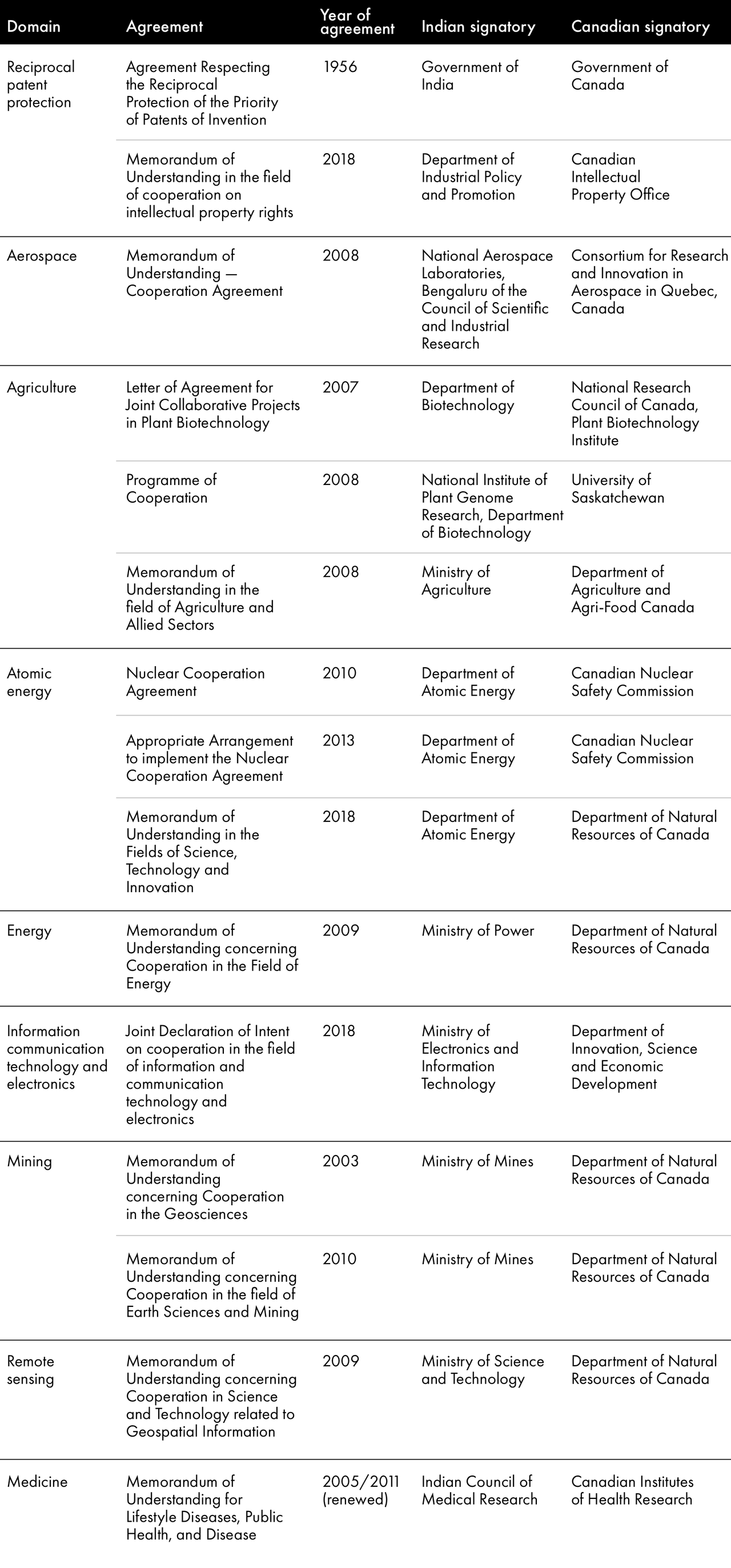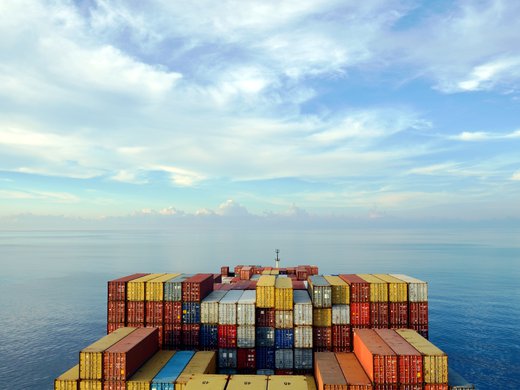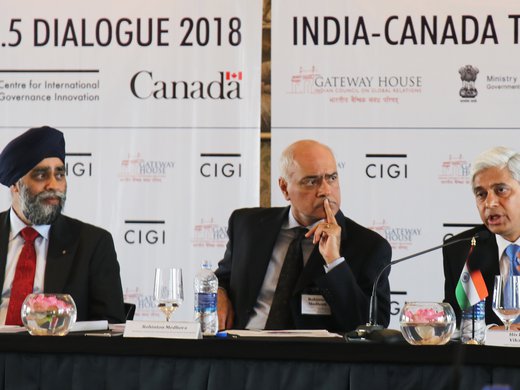Disappointment is often heard in New Delhi and Ottawa that diplomatic relations between India and Canada have yet to live up to their enormous collaborative potential. The bilateral relationship often gets entangled in politics and inertia. The Comprehensive Economic Partnership Agreement (CEPA) has been in the works for more than a decade now. Indeed, agriculture, mining, oil and gas, banking and insurance, and security cooperation are some of the bright spots of Indo-Canadian relations. However, one underused domain spans them all and can be a foundation for CEPA: scientific and technological innovation.
There is ample room for a better bilateral relationship. An ever greater Indo-Canadian blending of cultures, massive interest among Indian students for education at Canadian universities, Ottawa’s interest in securing agricultural exports to India, and India’s exports of specialty chemicals and heavy engineering goods to Canada, as well as a Canadian eye for investments in India’s massive infrastructure build-out, are just some areas of potential cooperation. The two countries’ shared concern about combatting climate change is fast becoming pivotal. Nonetheless, these shared interests have not yet evolved into mutually understood goals or targets.
Prime Minister Narendra Modi last visited Canada in April 2015, fully seven years ago. It had taken 42 years for an Indian prime minister to visit Ottawa. In contrast, high-level representatives of India and the United States, Canada’s next-door neighbour, have visited each other every few months, apart from the pandemic-effected months of 2020. Prime Minister Justin Trudeau visited India in February 2018; however, that trip was widely acknowledged as unsuccessful. Canada and India’s relationship was troubled for months afterward, entering an introspective mode.
Consider that the India-Canada economic partnership is estimated to be worth some $100 billion anually, with trade in goods estimated at $10.5 billion, trade in services around $5 billion, and Canadian portfolio investments around $24 billion (values throughout in US dollars). In 2020, Canadian imports from India were valued at $3.70 billion, and Indian imports from Canada at $2.76 billion; with respect to global trade with Canada, the total Indo-Canadian trade was abysmal, at 0.81 percent. The Canada Pension Plan Investment Board has shown keenness in investing in India’s net-zero transition assets portfolio. India’s stellar record in this regard, especially in ramping renewable energy generation capacities above 150 gigawatts from 17.5 gigawatts in 2010, its global leadership in the International Solar Alliance, and net-zero commitments by the year 2070 make India a promising investment destination for Canadian firms. But the factor weighing on such investments is that the science and technology (S&T) domain is underplayed in India-Canada bilateral relations.
India-Canada bilateral relations operate on two tracks. The larger of the two comprises ministerial dialogues on energy, finance, trade and investment, and foreign policy. The smaller track at the official or secretary level comprises working groups dedicated to S&T, education, agriculture, security and counterterrorism. Despite S&T being a common thread across the domains in both tracks, it has not yet been taken on at the higher level of ministerial dialogue.
Some history is in order. A bilateral partnership on S&T was institutionalized via a far-sighted treaty called the Agreement between the Government of Canada and the Government of India Respecting the Reciprocal Protection of the Priority of Patents of Invention signed in 1956. This agreement predated the 1967 revision of the Paris Convention for the Protection of Industrial Property (Paris Convention), the 1971 Paris Act of the Berne Convention for the Protection of Literary and Artistic Works (Berne Convention), and the 1995 Agreement on Trade-Related Aspects of Intellectual Property Rights (TRIPS Agreement), to which India and Canada later became signatories. Notably, the year the two countries signed their reciprocal agreement, 1956, was the same year that Canada supplied a 40 MWe (million watts of electric capacity) pressurized heavy-water reactor of the Canada deuterium uranium (CANDU) type, which later came to be known as CIRUS (Canada-India-Reactor-United States), placed at the Bhabha Atomic Research Centre in Mumbai, India. The American contribution to the term CIRUS came from its supply of heavy water for the same reactor.
Many decades later, a significant pact known as the Agreement for Scientific and Technological Cooperation Between the Government of Canada and the Government of the Republic of India was signed in 2005. This pact was based on the two governments’ rights and obligations as embodied in the 1967 Paris Convention, the 1971 Berne Convention, and the 1995 TRIPS Agreement. The 2005 agreement delineated the cooperation on non-defence research in health science, agricultural science, environmental science, aerospace research and mining. It also led to many inter-agency, inter-institutional and inter-ministerial agreements (Table 1); every one of these bilateral agreements has been beneficial not only to the government-supported institutions carrying out research and development (R&D) but also to industry in the two countries. According to article 7 of the 2005 agreement, the two countries also created a Joint Science and Technology Cooperation Committee, which has been laying action plans between their S&T agencies every two years. The most recent Joint S&T Cooperation Committee meeting took place in Ottawa on May 19, 2022. As an outcome of this meeting, the partners decided to prioritize bilateral collaborations, for the period of 2022–2024, in the domains of quantum and artificial intelligence, health science and related technologies, clean energy and environmental research, marine and polar research, agriculture and food security, and researcher mobility and human development.
Table 1: S&T Cooperation Agreements between Indian and Canadian Government Institutions

The Indo-Canadian bilateral scientific partnership has been underplayed for a long time. Because of these two economies’ size (according to World Bank data, India’s GDP in 2020 was approximately $2.65 trillion, while Canada’s GDP in the same year was approximately $1.65 trillion), as well as their diverse research pursuits, their industries’ R&D-oriented outlook, and the forward-looking academic research, both countries would benefit from much more than straightforward bilateral memoranda of understanding and letters of intent.
Unlike services start-ups, those working on the digital economy front, science and technology start-ups need long-duration financing and guidance, which often comes from strategic-minded venture capital.
Addressing these limitations was high on the agenda when a delegation led by Mary Ng, Canadian Minister of International Trade, Export Promotion, Small Business and Economic Development, visited New Delhi in March 2022. These high-level meetings signalled that the relationship between the two countries was warming again. The meeting between Minister Ng and Jitendra Singh (India’s Union Minister of State for Science and Technology) was a watershed moment in terms of identifying new synergies in S&T cooperation.
The highlight of the meeting was the establishment of a new India-Canada Bilateral Centre dedicated to S&T activities. New Delhi has been running such jointly financed centres for a long time: with Germany (since 2010), France (since 1987), the United Kingdom (since 2008), the United States (since 2000), and Japan (since 1993). Such centres typically manage all the bilateral S&T cooperation agreements and activities. These centres operate with finances pooled by two countries. They announce expressions of interest and funding calls and select projects based on the priorities set by the partner countries at regular intervals. Such centres also monitor the progress and performance of bilateral S&T projects. The planned India-Canada Bilateral Centre is expected to monitor joint scientific projects across multiple disciplines for their constructive impact on the relationship. From India’s experience with the other countries mentioned above, such centres have been productive foyers for people-to-people interactions and academia-industry partnerships, and are therefore a robust support to India’s science diplomacy. The upcoming bilateral centre has made a formal government-to-government pooling of finances possible.
The planned India-Canada Bilateral Centre is emerging against a backdrop of substantial partnerships developed by Indo-Canadian academia, government science agencies, and industries via the Vancouver-based not-for-profit IC-IMPACTS (India-Canada Centre for Innovative Multidisciplinary Partnerships to Accelerate Community Transformation and Sustainability). This not-for-profit, established in 2013, has supported research in domains such as clean tech, food security, climate and sustainability, infrastructure and public health. Many of these domains are of immense global significance. The COVID-19 pandemic has injected vigour in not only pandemic mitigation but several neglected aspects of holistic human health. The war in Ukraine has shown how armed conflict can disrupt global wheat supply chains and prove detrimental to global food security. Once again, the wise selection of domains between Indian and Canadian S&T interest groups shows how relevant bilateral science could be for solving global challenges.
With Canada and India having created dedicated mechanisms for academic S&T partnership, the elements now missing in their S&T collaboration are substantial synergies for the dynamic S&T start-up sector. S&T start-ups today have become bridges between government-sponsored early-stage R&D and private sector-led commercially ready R&D. Most of them are based on university campuses and in national laboratories where they benefit from the ecosystem of scientists and innovators. Investors, mainly those with a high-risk appetite to sustain long-gestation product development, flock to them from the outside world. Unlike services start-ups, those working on the digital economy front, S&T start-ups need long-duration financing and guidance, which often comes from strategic-minded venture capital.
Ottawa and New Delhi should determine a list of priority areas — agriculture, health, climate change, clean energy, mining, and oil and gas, to name several — where government could link up with academic and industry partners to brings start-ups into the orbit of a joint partnership agenda.
Over the past decade, Indian and Canadian entrepreneurs have successfully created platforms for exchanging ideas, developing collaborations and learning together. Some of these platforms are:
- the Indo-Canadian Entrepreneurship Exchange, an initiative of the University of Toronto and the Indian Institute of Technology Bombay;
- the India-Canada Startup Link, operated by Toronto Business Development Centre (a start-up accelerator) and Startup India, the Indian government’s flagship initiative; and
- the Global Bridge Canada-India Program, run by T-Hub, a leading start-up incubator in Hyderabad, India, and Canada’s Tech Network, a network of start-up incubators and accelerators in Canada.
These platforms are currently nurturing emerging S&T businesses in priority domains identified by both governments. However, there remains a lack of concrete bilateral policy for joint research and prototype development to be carried out by such enterprises.
Ottawa and New Delhi should determine a list of priority areas — agriculture, health, climate change, clean energy, mining, and oil and gas, to name several — where government could link up with academic and industry partners to brings start-ups into the orbit of a joint partnership agenda. Leaving out S&T start-ups will only impede the relationship’s massive potential.
Take, for instance, early-stage climate technology start-ups. In 2021, such enterprises globally were estimated to have raised $53.7 billion. Although the current focus is on the electrification of transportation, investments will likely be divided into the decarbonization of energy, transportation, industry, agriculture, carbon and climate, and building and infrastructure sectors in the coming years. India’s nascent climate tech start-up arena was able to secure a relatively meagre $445 million, but there will be an upward trend.
Indeed, at the twenty-sixth Conference of the Parties held in Glasgow in November 2021, Prime Minister Modi announced that India had a target of achieving net-zero emissions by the year 2070. Although Modi said that India would need $1 trillion for decarbonization purposes, subsequent studies estimate cumulative investments for the same to the tune of US$10 trillion.
Although the projected investments are massive, a stricter global regulation through emission reduction credits, emission trading schemes and other carbon offset financing, blockchain technology in managing carbon offset trading and credits will only make these investments more lucrative.
This “generational investment opportunity” has been identified by the Canada Pension Plan Investment Board. The fund expects to increase its investments in net-zero transition assets from the current $53 billion (in 2022) to $106 billion by 2030. The fund is aiming for an asset base of $3 trillion for its portfolio for a net-zero target in 2050. Sovereign wealth funds such as the Abu Dhabi Investment Authority, Dubai’s Mubadala Investment Company and Singapore’s GIC Holdings have already begun investing in India’s environmental, social and governance projects. An India-Canada strategy to catalyze start-ups to achieve net-zero emissions will be crucial.
India and Canada’s science diplomacy need not operate in isolation. This fusion has the potential to echo and support ongoing partnerships in agriculture, atomic energy, mining, oil and gas, biotechnology, health and medicine, digital trade and other non-scientific bilateral pursuits.
The priority areas of the India-Canada S&T partnership are of immense significance to achieving the net-zero emission targets of both nations. Investment through state-backed funds will largely come through the start-up and industrial sectors, rather than via academia. Accordingly, a thoughtful discussion is needed when the Joint Science and Technology Cooperation Committee next meets in 2024.
The impact of S&T start-ups is not limited to the priority areas. India and Canada are yet to tap robust partnerships in space and ocean exploration.
India is in the advanced stages of accomplishing its first human spaceflight, currently scheduled for 2023; the mission is the first of the Indian Human Space Flight Programme. By the turn of the next decade, the Indian Space Research Organisation aims to set up a compact and modular space station in low-Earth orbit. The Canadian Space Agency has tremendous operational experience with the International Space Station. Canadian universities and start-ups can carry out natural science and commercial science experiments on the planned Indian space station. India’s space start-up ecosystem is currently nurturing several space launch service start-ups. With the traffic to Earth’s orbit on the increase, India and Canada can develop a reciprocal agreement for sharing commercial space launch sites in both countries. This agreement would benefit the upcoming commercial spaceport near Canso, Nova Scotia, that is likely to see the first space launch in 2023.
Likewise, India is also in the advanced stages of building a deep submergence vehicle, known as Samudrayaan, part of its ambitious Deep Ocean Mission led by the country’s Ministry of Earth Sciences. India can also seek S&T partnership with Canadian institutions to research exploring and conserving marine biodiversity, setting ocean climate change advisory services, the survey and exploration of the ocean floor, ocean energy projects, and developing ocean debris removal technologies. Here again, Canada’s work with its Ocean Supercluster, the industry-led ocean technology innovation ecosystem, will be of immense help to Indian institutions. Many of India’s and Canada’s capacities can be put together to help offer ocean technology solutions to Indo-Pacific countries.
In short, potential for Indian and Canadian cooperation in S&T is vast. Although the Joint Science and Technology Cooperation Committee has identified areas of partnership, these have not yet flowered. This lethargy has been due to a diplomatic inability to conjoin mutual economic aspirations with S&T. Better late than never: the renewed vigour in the relationship seen during the COVID-19 pandemic is a good sign. The two governments appear ready to infuse new energy into their engagements and open up new fronts of S&T cooperation.
India and Canada’s science diplomacy need not operate in isolation. This fusion has the potential to echo and support ongoing partnerships in agriculture, atomic energy, mining, oil and gas, biotechnology, health and medicine, digital trade and other non-scientific bilateral pursuits.
Indeed, these two countries may differ on specific global issues, but success in bilateral work requires a multi-pronged approach. When economic and political diplomacy falter, science diplomacy must be put to work. The two countries have engaged in bilateral diplomacy for the sake of science until now. It is time for them to employ science, for the sake of diplomacy.



